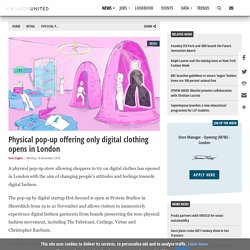

New Report Looks at the Rise of Virtual Influencers on Instagram. Social media was created to facilitate human connection, to amplify our interactive capability by providing new ways for us to share our lives and experiences, and relate to others around the same.

Social media gurus have been preaching along these lines for years - in order to succeed on social platforms, you need to 'be more human', you need to 'humanize your brand', 'it's human connection that matters'. And while there are many examples of such approaches leading to greater success for brands online, there is another, rising trend which largely goes against this, and brings into question the very future of the form. That trend is the rising popularity of virtual influencers - computer-generated models which are gaining popularity, especially on Instagram.
Virtual influencers, as you can see here, run a broad spread of variation - from so close to real that you can't tell, to cartoonish, Sim-like characters which seem completely out of place. And the numbers speak for themselves: Virtual influencers: Lil Miquela and Shudu Gram are online marketing’s future. 3D renders that give the impression of living the perfect Instagram life, virtual influencers are the latest addition to the world of brand marketing.

Phygital: The Simple Guide for 2020 and Beyond [+ Real Life Examples] You might already know the concept of Phygital Marketing from its previous iteration, Immersion Marketing.
![Phygital: The Simple Guide for 2020 and Beyond [+ Real Life Examples]](http://cdn.pearltrees.com/s/pic/th/phygital-simple-examples-213372128)
The new catch-phrase name conveys this marketing strategy’s meaning more clearly, though: Phygital = Physical + Digital. Technology: Digital fashion: Why the industry should embrace e-sports and gaming. The fact that the fashion industry is being digitally disrupted along its entire value chain is no news.

Why digital clothing is the next fashion frontier. Key takeaways: Scandinavian retailer Carlings sold out of a digital clothing collection in a week.

Digital tailors manipulated customer photos so it appeared that they were dressed in the apparel, which cost up to €30 per piece.Mobile games have already proved that customers are willing to spend money on digital assets. Glu Mobile’s Covet Fashion game generated $53.4 million in sales last year (a portion from advertising).While there are obvious opportunities for fashion brands, there are significant barriers to entry.
Designers are traditionally unschooled in 3D modelling, sample patterns are not easily converted to 3D models and automated technologies are nascent. Looks from Carlings's digital collection. What is digital clothing? Fashion influencers live and die by their outfit posts.

What Is Digital Clothing? And Will We All Be Dressing Virtually In The Future? Picture this: you’re browsing online and a statement jacket suddenly catches your eye. Metallic, with flashes of lime green; it's unlike anything you’ve seen before. After some umming and ahhing, you decide to buy it. Instead of ever seeing it in person, though, you supply a photo of yourself and the same image is then sent back with your newly purchased jacket edited onto you. Carlings releases "The Last Statement T-shirt" with slogans viewable in AR. Swedish retailer Carlings has released its augmented-reality The Last Statement T-shirt, which can show a variety of political messages.

Developed for the brand by creative agency Virtue, the T-shirt is nearly blank to the naked eye. Viewed through a phone, however, it sports a bold, animated design that comments on a political topic of the day. The wearer can choose from a range of graphics created especially for The Last Statement T-shirt and accessible through the Instagram or Facebook apps, where it works on the same principle as face filters.
New Order of Fashion — Studio PMS. Inside the physical store that only offers digital clothes. Key takeaways: Hot Second, a London pop-up running from 19 to 21 November, is the world’s first digital clothing store.Visitors can try on — but not purchase — digital garments in exchange for an unwanted item of clothing.Brands are beginning to experiment with virtual garments, but are unsure how they will monetise them.

A London pop-up is testing how consumers react to digital clothes. Hot Second invites visitors to donate an unwanted piece of clothing in exchange for a digital garment. Guided by a human “digital tailor”, guests are led into pods equipped with a camera, projector and a “magic mirror” to sample looks from British designer Christopher Raeburn and digital clothing pioneers The Fabricant and Carlings.
While no physical versions are available for purchase, shoppers can take home the digital images and one photo print-out of them in the garment of their choice. The Fabricant is a Dutch digital design house that makes only digital designs, such as this one. How 3D Digital Design and Augmented Reality Can Slash Textile Waste In Fashion Image: Ethmode 3D digital Bodysuit, BRIA Fashion tech innovator, writer and public speaker Brooke Roberts-Islam investigates the role that 3D digital design and augmented reality can play in reducing textile waste in the fashion industry.

Much is said about the millions of tonnes of garments thrown away each year, urging us to be more sustainable by wearing our clothes more often, washing them less and keeping them out of landfill, but what about the waste generated in the fashion design process itself? What about the carbon emissions generated in the pre-consumer phase of the fashion industry? Physical pop-up offering only digital clothing opens in London. A physical pop-up store allowing shoppers to try on digital clothes has opened in London with the aim of changing people's attitudes and feelings towards digital fashion.

Www.forbes. Digital transformation of fashion design and manufacturing is viewed as both an opportunity and a threat, depending on who you ask. The perceived threats include job security, creativity, and loss of the “human touch” in fashion design and garment-making. The opportunities span time and cost savings, vast and swift sustainability gains (including removing textile waste and reducing the need for dyeing, water use and the carbon emissions generated by physical sampling) and the ability to manufacture small quantities of products profitably. Other creative industries, such as gaming and film, have adopted digital tools and subsequently platforms that link design, the beating heart of all the products created for human consumption, with every other person and process necessary to bring that design to life (whether that be on a screen or in physical form).
Digital meets physical, defining the retail landscape in 2020. Over the past few years the retail landscape has been evolving at rocket speed with 2020 set to be the definitive year of immersive retailing. The much talked about ‘store of the future’ must, in fact, become reality today. As digital and bricks & mortar strategies merge to co-exist, the retail apocalypse of the 2010’s which saw a surge in shop vacancies, has fuelled the era of temporary store spaces and pop-up models.
According to retail and data analysts Edited, temporary instalments, brand activations and in-store sensory experiences are here to stay. With the autumn winter show season starting in January, designers will continue to explore and innovate with these concepts to generate hype alongside their latest collections. Asos launches virtual catwalk. The new shopping experience marks Asos’s first augmented reality (AR) experience and offers customers a new way of viewing its products in real life.
Customers can point their device at a flat surface, click the “AR” button on the product page, and models will appear “in front of them” wearing the product. The feature, developed in partnership with AR company HoloMe, is available now through the Asos app on iOS 11.3 devices. How HOT:SECOND brought digital fashion into physical retail - Insider Trends. Last month an innovative new retail space popped up in London’s Shoreditch. Billed as a ‘world first circular economy concept store’, HOT:SECOND was a space that invited customers to trade physical products for a digital fashion experience.
By bringing in an unloved garment, rather than throwing it out, visitors had the chance to try on a digital fashion garment from leading brands like The Fabricant, Carlings/VIRTUE and RÆBURN. The hope was that by combining physical retail and digital products a new type of fashion experience could be offered. HOT:SECOND also hopes to change perceptions around digital fashion by giving curious fashion fans the chance to explore it for themselves. Digi-Gal’s campaign for Selfridges envisions the future of fashion in mesmerising virtual scenes.
“AI is definitely the king right now”: meet multimedia artist Eamonn Freel. Avoiding stereotypical generation marketing: Millennials and beyond. The segments are derived by applying advanced statistical analysis (cluster analysis) to 75 attitude statements addressing consumers’ shopping behavior, channel preferences and attitudes toward innovation, brand, convenience, health and wellness, and technology relating to purchasing consumer products. Inspired by The Sims, Sensergy creates an avatar-based campaign for knitwear brand AGR. AR filters for clothing come to Instagram. Key takeaways: